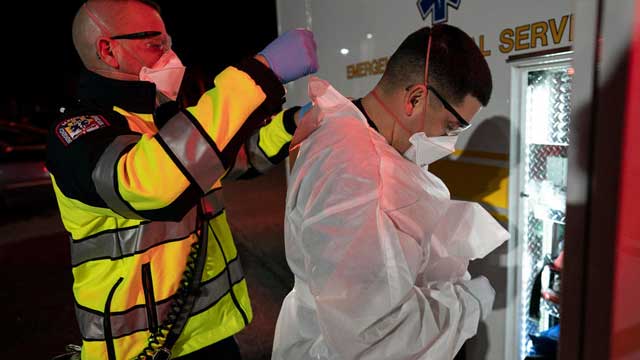
Glen Burnie, United States | AFP | In Glen Burnie, Maryland, the coronavirus is never far away for emergency teams of paramedics and firefighters on call over 24-hour shifts.
In the suburban community south of Baltimore, these first responders have had to adapt everything they do to the COVID-19 threat, even for emergency calls unrelated to the pandemic.
But many calls are: already, 350 people have died from coronavirus in Maryland, out of more than 30,000 across the United States.
The team from the Anne Arundel County Fire Department operates on a 24-hour shift beginning at 7 am.
When they get a call that might involve coronavirus, they suit up completely in the PPE (personal protective equipment) required to lessen the chance they could contract it: gowns, masks, gloves and goggles.
At about 2:00 AM, they respond to a 911 call from an elderly woman who complained of breathing issues and wanted to go to the hospital.
With the constant threat of COVID-19, when they first arrive, the firefighters and paramedics keep their distance while trying to determine how serious her condition is.
It’s not easy — people like her are usually more comforted by seeing a human face. But the rescue crew has to keep their masks on.
Eventually, they figure out her symptoms are not serious. They calm her and try to convince her to stay home. But because she wanted to go, they took her to the hospital.
The 911 dispatcher sends them to another aged woman complaining of chest pains. She has no COVID-19 symptoms, but she might be having a heart attack.
Nevertheless, their first concern is taking precautions against the virus. Only one paramedic enters her home, fully garbed in PPE.
Ultimately they find she has other health issues and decide she does need hospitalization. The team wheels her off to the ambulance in a gurney.
Another call comes into the 911 dispatch center: a person says they have not heard from a family member for sometime, and could the Anne Arundel County Fire Department team go check on him?
One key point of information: the man had been experiencing some COVID-19 symptoms and was under quarantine.
No one answers at the front door, so one of the responders breaks through with an axe. But they are too late: the man had died several hours earlier. The case is handed over to the police, and the team heads back to their base, awaiting the next call.
It’s a long shift, fraught with anxiety over the invisible threat of the virus. At home, like everyone else, they have to isolate themselves in the community.
Usually they can leave the accidents and the fires they see on the job behind. But these worries don’t disappear. With COVID-19, there is always the risk that the virus comes home with them.
 The Independent Uganda: You get the Truth we Pay the Price
The Independent Uganda: You get the Truth we Pay the Price



